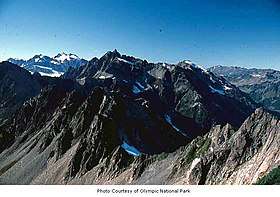Mount Meany
Mount Meany[3] is a prominent 6,695-foot (2,041-metre) mountain summit located deep within Olympic National Park in Jefferson County of Washington state. With a good eye and clear weather, the top of the mountain can be seen from the visitor center at Hurricane Ridge. Its nearest higher peak is Circe (6847 ft) on Mount Olympus, 4.07 mi (6.55 km) to the northwest.[1] There are scrambling routes on the east side, via Noyes-Meany col, and via the ridge from Mount Queets.[2] Due to heavy winter snowfalls, Mount Meany supports several small glaciers on its north and east slopes, despite its modest elevation. Precipitation runoff from the mountain drains into the headwaters of both the Elwha and Queets Rivers.
| Mount Meany | |
|---|---|
 | |
| Highest point | |
| Elevation | 6,695 ft (2,041 m) [1] |
| Prominence | 1,895 ft (578 m) [1] |
| Coordinates | 47°45′03″N 123°35′52″W [1] |
| Geography | |
 Mount Meany Location of Mount Meany in Washington  Mount Meany Mount Meany (the United States) | |
| Location | Olympic National Park Jefferson County, Washington, US |
| Parent range | Olympic Mountains |
| Topo map | USGS Mount Queets |
| Geology | |
| Age of rock | Eocene |
| Type of rock | pillow basalt |
| Climbing | |
| First ascent | 1907 Asahel Curtis, Lorenz Nelson, Peter McGregor |
| Easiest route | Scrambling YDS 3 [2] |
History
.jpeg)
The present day Mt. Meany - Mt. Queets area was referred to as Mt. Mesachie on the 1896 Gilman National Geographic Map.[4] The word mesachie is from the Chinook Jargon and means wicked.[5]
The mountain was named during the 1889-90 Seattle Press Expedition to honor Edmond S. Meany (1862-1935), at that time an employee of the Seattle Press who arranged the meeting between the expedition's newspaper sponsor, with Canadian James Halbold Christie, the leader of group of five which ascended the Elwha River and descended the North Fork Quinault River.[4] Meany later became a renowned scholar and professor at the University of Washington, a Washington state legislator, and also a mountain climber who served as president of The Mountaineers.
The first ascent of the mountain was made August 8, 1907, by Asahel Curtis, Lorenz Nelson, and Peter McGregor.[2][4]
Climate
Based on the Köppen climate classification, Mount Meany is located in the marine west coast climate zone of western North America.[6] Most weather fronts originate in the Pacific Ocean, and travel northeast toward the Olympic Mountains. As fronts approach, they are forced upward by the peaks of the Olympic Range, causing them to drop their moisture in the form of rain or snowfall (Orographic lift). As a result, the Olympics experience high precipitation, especially during the winter months. During winter months, weather is usually cloudy, but, due to high pressure systems over the Pacific Ocean that intensify during summer months, there is often little or no cloud cover during the summer. In terms of favorable weather, the best months for climbing are June through September.

See also
References
- "Mount Meany". Peakbagger.com.
- climbersguideolympics.com Mount Meany
- "Mount Meany". Geographic Names Information System. United States Geological Survey. Retrieved 2019-01-21.
- Parratt, Smitty (1984). Gods and Goblins: A Field Guide to Place Names of Olympic National Park (1st ed.).
- Beckey, Fred (2003). Cascade Alpine Guide: Climbing and High Routes, Stevens Pass to Rainy Pass. The Mountaineers Books. pp. 353–355. ISBN 978-0-89886-838-8.
- Peel, M. C.; Finlayson, B. L. & McMahon, T. A. (2007). "Updated world map of the Köppen−Geiger climate classification". Hydrol. Earth Syst. Sci. 11: 1633–1644. ISSN 1027-5606.
External links
- "Olympic National Park". National Park Service.
- Mount Meany weather: Mountain Forecast